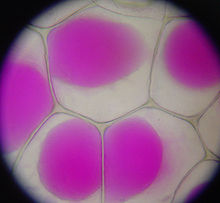Vacuole
| Parent |
| Organelle |
| Subordinate |
|
Vacuole membrane glycocalyx lumen protein complexes |
| Gene Ontology |
|---|
| QuickGO |

Vacuoles are cell organelles . They are built similarly to vesicles , but comprise much larger spaces enclosed by a membrane . Due to their size, they can also be seen under a light microscope . They occur, for example, as food vacuoles that have formed from parts of the cell membrane through phagocytosis .
The cell sap vacuole (also called the central vacuole or cell sap space) is particularly noticeable. In mature plant cells, it usually takes up the largest volume of the cell . The membrane that separates the vacuole from the adjacent cytoplasm is called the tonoplast . Inside the vacuole there is a liquid, the cell sap, which, in contrast to the cytosol, contains very few proteins and is therefore not plasmatic. Vacuoles can have the following tasks:
- Generation of a plump state of the cell through the turgor
- Substance stores of proteins , organic compounds and ions , i.e. substances that have a toxic effect or could disrupt the metabolism
- By storing poisonous or bitter substances, you can protect yourself from animal damage or fungal attack (e.g. calcium oxalate crystals )
- By storing dyes in the cell sap, parts of the plant can be given a special color: blue-violet-red are often anthocyanins that form red salts with acids and blue salts with bases (hollyhock, cornflower, hydrangea flowers ), flavones ( primrose flowers , Snapdragons )
- They also play a role in growth and movement processes through the osmotic uptake of water into the vacuole
- Digestion of macromolecules (see lysosomes in animals)
- Storage function - for example in legumes , in whose cotyledons vacuoles with storage proteins can be found.
- When wounded, tannins form a disinfecting layer and stop the proteins of the cytoplasm (wound closure)
The formation of a vacuole takes place during cell growth . Within the elongation of the plant cell, the volume of the cell increases through osmotic water uptake. However, since the substance of the cytoplasm does not grow with it quickly enough, cavities are created which are then separated from the adjacent plasma by tonoplasts . At the end of growth, the central vacuole often takes up such a large space that the cytoplasm only forms a thin layer between the plasmalemma and tonoplast. This is how the central vacuole is created.
